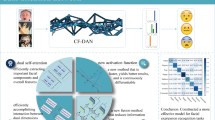Abstract
Indeed, object classification is one of the most advanced fields in computer vision today, and there are ongoing efforts to classify datasets used in real-world industries, beyond just public experimental data. Facial expression recognition is indeed one of the most prominent examples of such tasks, closely related to the Human-Computer Interaction (HCI) industry. Unfortunately, facial expression classification tasks are often more challenging compared to classifying public benchmark datasets. This paper aimed to address these challenges by mimicking human facial expression recognition processes and proposed an attention network that leverages high-frequency components to recognize expressions, inspired by how humans perceive emotions. The presented attention module vectorizes the singular value matrices of the query (the high-frequency component of the 1-channel input tensor) and the key (the 1-channel input tensor) and prepares a pairwise cross-correlation matrix by performing an outer product between them to create the attention scores. The correlation matrix is transformed into an attention score by passing through a convolution layer and sigmoid function. After that, it is used for element-wise multiplication with the value (input tensor) to perform attention. This paper conducted experiments using the ResNet18 and MobileNetV2 models along with the FER2013, JAFFE, and CK+ datasets to demonstrate the significant impact of the proposed attention module. The experimental results in this study have demonstrated the effectiveness of the proposed attention network and suggest its potential significance in real-time facial expression recognition tasks.
This result was supported by “Regional Innovation Strategy (RIS)" through the National Research Foundation of Korea(NRF) funded by the Ministry of Education(MOE)(2021RIS-003).
Access this chapter
Tax calculation will be finalised at checkout
Purchases are for personal use only
Similar content being viewed by others
References
Bahdanau, D., Cho, K., Bengio, Y.: Neural machine translation by jointly learning to align and translate. arXiv preprint arXiv:1409.0473 (2014)
Cubuk, E.D., Zoph, B., Mane, D., Vasudevan, V., Le, Q.V.: Autoaugment: learning augmentation policies from data. arXiv preprint arXiv:1805.09501 (2018)
Dagli, R.: Astroformer: more data might not be all you need for classification. arXiv preprint arXiv:2304.05350 (2023)
El Boudouri, Y., Bohi, A.: Emonext: an adapted convnext for facial emotion recognition. In: 2023 IEEE 25th International Workshop on Multimedia Signal Processing (MMSP), pp. 1–6 (2023). https://doi.org/10.1109/MMSP59012.2023.10337732
Fard, A.P., Mahoor, M.H.: Ad-corre: adaptive correlation-based loss for facial expression recognition in the wild. IEEE Access 10, 26756–26768 (2022). https://doi.org/10.1109/ACCESS.2022.3156598
Foret, P., Kleiner, A., Mobahi, H., Neyshabur, B.: Sharpness-aware minimization for efficiently improving generalization. arXiv preprint arXiv:2010.01412 (2020)
Georgescu, M.I., Ionescu, R.T., Popescu, M.: Local learning with deep and handcrafted features for facial expression recognition. arXiv preprint arXiv:1804.10892 (2018)
Gesmundo, A., Dean, J.: An evolutionary approach to dynamic introduction of tasks in large-scale multitask learning systems. arXiv preprint arXiv:2205.12755 (2022)
Goodfellow, I.J., et al.: Challenges in representation learning: a report on three machine learning contests. In: Lee, M., Hirose, A., Hou, Z.-G., Kil, R.M. (eds.) ICONIP 2013. LNCS, vol. 8228, pp. 117–124. Springer, Heidelberg (2013). https://doi.org/10.1007/978-3-642-42051-1_16
He, K., Zhang, X., Ren, S., Sun, J.: Deep residual learning for image recognition. In: Proceedings of the IEEE Conference on Computer Vision and Pattern Recognition, pp. 770–778 (2016)
Hu, J., Shen, L., Sun, G.: Squeeze-and-excitation networks. In: Proceedings of the IEEE Conference on Computer Vision and Pattern Recognition, pp. 7132–7141 (2018)
Krizhevsky, A.: Learning multiple layers of features from tiny images (2009). https://api.semanticscholar.org/CorpusID:18268744
Liu, Z., Luo, P., Wang, X., Tang, X.: Deep learning face attributes in the wild. In: Proceedings of International Conference on Computer Vision (ICCV) (2015)
Lucey, P., Cohn, J.F., Kanade, T., Saragih, J., Ambadar, Z., Matthews, I.: The extended cohn-kanade dataset (ck+): a complete dataset for action unit and emotion-specified expression. In: 2010 IEEE Computer Society Conference on Computer Vision and Pattern Recognition - Workshops, pp. 94–101 (2010). https://doi.org/10.1109/CVPRW.2010.5543262
Lyons, M.J.: “excavating AI” re-excavated: debunking a fallacious account of the jaffe dataset. arXiv preprint arXiv:2107.13998 (2021)
Lyons, M.J., Kamachi, M., Gyoba, J.: Coding facial expressions with gabor wavelets (ivc special issue). arXiv preprint arXiv:2009.05938 (2020)
Minaee, S., Abdolrashidi, A.: Deep-emotion: facial expression recognition using attentional convolutional network. arXiv preprint arXiv:1902.01019 (2019)
Park, J., Woo, S., Lee, J.Y., Kweon, I.S.: Bam: bottleneck attention module. arXiv preprint arXiv:1807.06514 (2018)
Park, M., Lee, J.N., Cho, J., Kim, Y.J., Yoon, J., Whang, M.: Facial vibration analysis for emotion recognition (2016). https://api.semanticscholar.org/CorpusID:137695591
Park, S., Jung, W.: The effect of spatial frequency filtering on facial expression recognition and age perception. Korean J. Cogn. Biol. Psychol. 18(4), 311–324 (2006)
Paszke, A., et al.: Pytorch: an imperative style, high-performance deep learning library. Adv. Neural Inf. Process. Syst. 32 (2019)
Pecoraro, R., Basile, V., Bono, V., Gallo, S.: Local multi-head channel self-attention for facial expression recognition. arXiv preprint arXiv:2111.07224 (2021)
Ridnik, T., Sharir, G., Ben-Cohen, A., Ben-Baruch, E., Noy, A.: Ml-decoder: scalable and versatile classification head. arXiv preprint arXiv:2111.12933 (2021)
Sandler, M., Howard, A., Zhu, M., Zhmoginov, A., Chen, L.C.: Mobilenetv2: inverted residuals and linear bottlenecks. In: Proceedings of the IEEE Conference on Computer Vision and Pattern Recognition, pp. 4510–4520 (2018)
Selvaraju, R.R., Cogswell, M., Das, A., Vedantam, R., Parikh, D., Batra, D.: Grad-cam: visual explanations from deep networks via gradient-based localization. In: Proceedings of the IEEE International Conference on Computer Vision, pp. 618–626 (2017)
Tan, M., Le, Q.: Efficientnet: rethinking model scaling for convolutional neural networks. In: International Conference on Machine Learning, pp. 6105–6114. PMLR (2019)
Vaswani, A., et al.: Attention is all you need. Adv. Neural Inf. Process. Syst. 30 (2017)
Author information
Authors and Affiliations
Corresponding author
Editor information
Editors and Affiliations
Rights and permissions
Copyright information
© 2024 The Author(s), under exclusive license to Springer Nature Singapore Pte Ltd.
About this paper
Cite this paper
Kim, S., Jo, K. (2024). Spatial Attention Network with High Frequency Component for Facial Expression Recognition. In: Irie, G., Shin, C., Shibata, T., Nakamura, K. (eds) Frontiers of Computer Vision. IW-FCV 2024. Communications in Computer and Information Science, vol 2143. Springer, Singapore. https://doi.org/10.1007/978-981-97-4249-3_11
Download citation
DOI: https://doi.org/10.1007/978-981-97-4249-3_11
Published:
Publisher Name: Springer, Singapore
Print ISBN: 978-981-97-4248-6
Online ISBN: 978-981-97-4249-3
eBook Packages: Computer ScienceComputer Science (R0)




